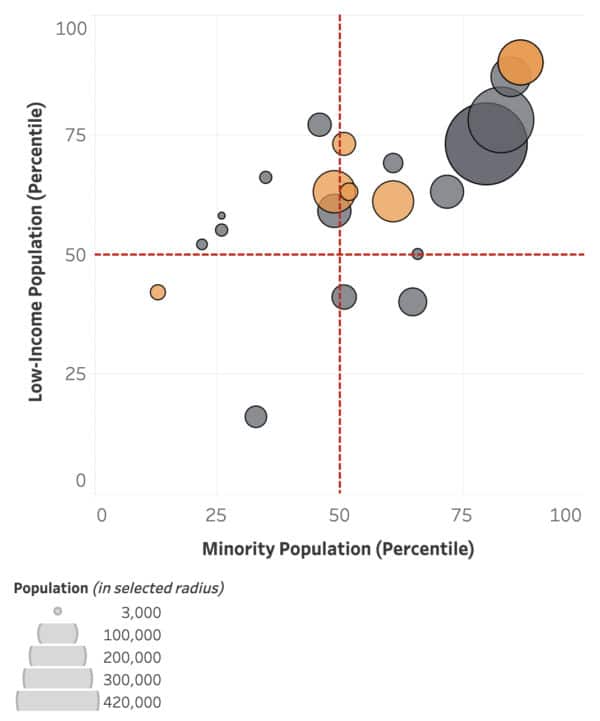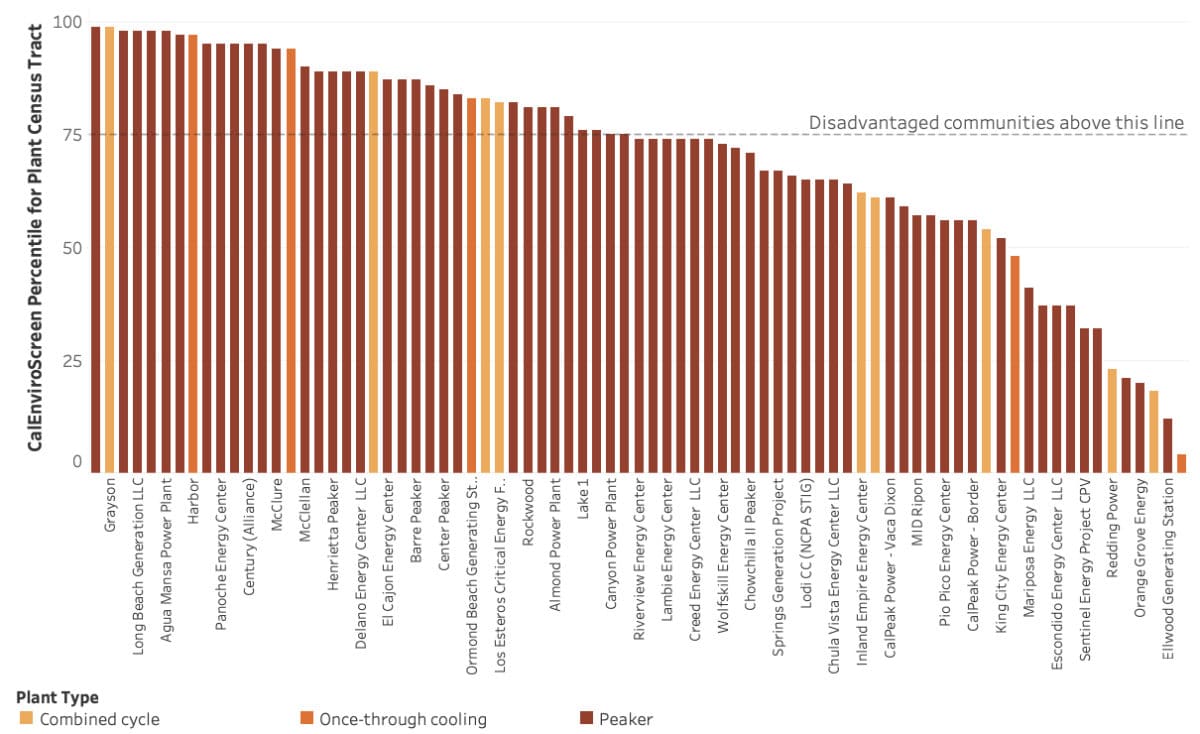Peaker generating units causing the greatest health burdens can be retired and replaced with storage. That’s the idea behind a new data visualization resource from Physicians, Scientists, and Engineers for Healthy Energy (PSE).
The U.S. has more than 1,000 peaker units, which operate only at times of peak load, and often have high hourly emissions. Many are located in areas with high proportions of minority and low-income residents.
PSE aims to speed the replacement of peakers with storage, starting in nine states with favorable policy environments. The group says on its website that renewable energy and storage “are beginning to emerge as competitive replacements” for existing peakers.
“This is a screening tool,” said PSE Director of Research Elena Krieger, “and we hope it will catalyze deeper analytical dives into specific regions or power plants.”
Seeing the data
PSE provides a data visualization tool and a report for each of nine states with storage-friendly policies or a good pace of storage deployment. The states are, from west to east, California, Nevada, Arizona, New Mexico, Texas, Florida, New York, New Jersey, and Massachusetts.
The Massachusetts map, for example, uses varying sizes of circles to show the locations and sizes of 23 peaker units. Clicking on a circle brings up 20 data elements on the unit’s status, age, operations and emissions.
The user can filter the data to select which peakers to show, both on the state map and on a chart showing the proportion of low-income and minority residents living nearby. Filtering options include a peaker unit’s operating status, emissions level, age, and capacity factor.

The chart varies the size of the circles according to the number of people living nearby, as in the chart for Massachusetts shown at right. Here, gray circles indicate oil-fired peakers, and orange represents gas-fired peakers.
An accompanying report for each state describes the state’s clean energy policies, and shows the data for all peaker units in a single table. The report for Arizona, for example, notes that a peaker unit’s age, efficiency, and utilization rate could be factors considered when evaluating retirement. Each state report also has state-specific images, such as the California ranking of peaker units shown above.
Who might use it
“Regulators and policymakers can use our findings to inform decisions related to energy storage and clean energy targets, greenhouse gas and criteria pollutant emission reductions, and investments to improve clean energy access for under-served and vulnerable communities,” said Krieger. “Hopefully, our analysis will highlight the need to break down the barriers between these historically siloed efforts.”
Krieger also noted the potential for community groups to use the tool to support their clean energy, equity and pollution-related efforts. “Plants serving load pockets near vulnerable and disadvantaged communities could potentially be replaced with distributed clean energy technologies that improve clean energy access and resilience,” she said.
Storage developers could use the tool to screen “for states and regions where peaker plants may be vulnerable to retirement, and where energy storage and other alternatives align well with peak demand needs,” Krieger noted. “Aging plants with short run times, poor efficiency, and low capacity factors may be more likely to be economically vulnerable to retirement and more easily replaced with battery systems,” she said.
On the other hand, peaker units “with low emission rates and located far from population centers are likely to be less of a priority” for early retirement, “from a health and equity standpoint.”
Overall, Krieger said that PSE’s approach “can help set a precedent for broader grid-wide clean energy transitions to incorporate health, environment and equity co-benefits.”
This content is protected by copyright and may not be reused. If you want to cooperate with us and would like to reuse some of our content, please contact: editors@pv-magazine.com.








All the Utility infrastructure is already in place at peaker plants ready to add Batteries and inverters and just tie into the lines already in use by the turbines at the plant. With batteries, a peaker plant could run and charge up the batteries ahead of time and double the output in an emergancy with instant on from the batteries like in California where long distance power lines are shut off in high wind events.
The first thing that has to happen, is the rote electric utility to accept the fact that spinning demand and spinning reserve fueled plant operations is no longer cost effective or wise. The second is to get away from the 4 hour energy storage solution and begin to “matrix” energy storage power blocks as switchable n by n entities to create the power production output as well as the time a particular amount of generation will be needed. One could have hundreds of 1MW/4MWh energy storage cargo containers on several acres of a solar PV or wind farm. Having power blocks available could allow 100MWh of generation for 4 hours, or 10MWh for 40 hours. It all depends on how cargo container units are switched into the system and what the grid demand is at a particular time of the day or night. NOT curtailing solar PV or wind generation, but storing it for later use is the best practices of handling non-fueled and intermittent energy generation. The aspects of air quality and health benefits, mechanical fueled generation cannot react to grid demands like a stored high voltage D.C. buss that is switched at 60Hertz into the grid. Electronic switching inverters can react to grid demands in milliseconds to seconds. Mechanical generation will just not do it.
Peakers are outdated tech not needed and only still around because they are paid for.
Using them as an excuse to justify grid batteries by hiding the battery cost in solar isn’t being honest.
What little need for them, grid batteries, disappeared with load following NGCCGTs.
Note they don’t put in grid batteries unless mandated or paid with a grant.
To replace them you need more generation like solar which has already cut peak demand by large amounts. In Cal so much it kicked peak demand from afternoon into late evening leaving the duck curve as all that is left.
The real storage will be at retail in homes, buildings, EVs with batteries, heat/cold storage, etc behind the grid.
And these because so many will supply the grid with on demand power for income and suck up excess power stopping curtailments, balancing a 100% grid..
With batteries, a peaker plant could run and energize the batteries early and twofold the yield in an emergency with moment on from the batteries like in California where significant distance electrical cables are stopped in high wind occasions. NOT shortening sunlight based PV or windage, however putting away it for later use is the prescribed procedures of dealing with non-energized and irregular vitality age. The parts of air quality and medical advantages, mechanical filled age can’t respond to network requests like a put away high voltage.